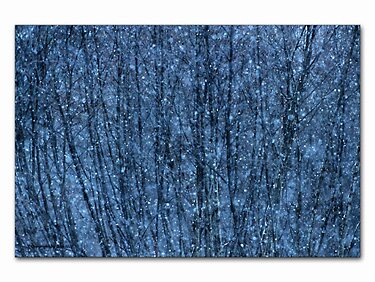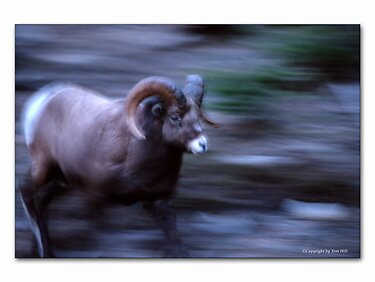

All Images And Text On This Site Are Copyright 1999-2001
by
Thomas D. Hill Jr.
| ABOUT KEIKO |
| WHAT'S NEW |
| THE KEIKO GALLERY |
| EQUIPMENT |
| IMAGE OF THE MONTH |
| ARTICLE OF THE MONTH |

11 July 2001
I'm writing this as two fairly significant events are unfolding in my life. Okay, one important event and one yet to be determined. The first event is I'm writing this on my iBook--a computer for those non-Mac people out there--in a campsite near Mono Lake California. The location itself doesn't offer much significance. The reason for the location is much more important--I'm moving from Cold Lake Canada to Edwards AFB USA. Mostly this wouldn't be much of an issue for someone that's used to moving every two or three years. This time is unique because Cold Lake has had a significant impact on my life. I discovered photography--again--and nothing will ever be the same. The surprising contribution from being on the road is the amount of time to consider things. That's not foriegn to me. I normally address issues such as the meaning of life when driving endlessly on the highways. Okay, sometimes I've been known to practice raising eyebrows independently. Anyway, this trip was highlighted by the lack of highway travel. All but 60 miles of the 3,000 mile trip were driven on what most American's call the "backroads". Life looks a lot different on those roads than on the highways. The where for's and why for's are worthy of their own article and I won't get into it now. Just know the countryside is significantly different and therefore promotes idle thoughts of a driver endlessly driving towards certain, more natural issues. The one I'm tackling now is the nature of a quality image. Or, the Quality of images.
In conjunction with this trip, the second major event has occured. Whether it's premature to declare the significant of this second event or not, I don't care. I expect it will so I'll state it here now. The event is the reading of Prising's "Zen and the Art of Motorcycle Maintenance". For those not familiar, the book address lots of philosophy but most uniquely it brings up the discussion of the classic and romantic worlds. To help a bit, I'll say it discusses the worlds of the left and rides sides of the brain. The technical and artistic sides of the world. The point here for this article is what brings them together to produce insightful images--Quality. It's the thing that bridges the technical and artistic aspects to an image. Quality is what joins the technical portions with the artistic portions to bring a final image together. Take my word for now that this is true and we'll get into the why's later.
First, I say making images is mostly made up to two major frames of mind. You need to have the technical expertise to accomplish the task and you need to have an artistic vision to guide what you're doing. Sure, there are lots of details of what goes on in producing an image. But, if you get right down to it, these two worlds are what's needed to make great images. The technical and artistic aspects are critical to photography. In fact, you have to have a balance of both to make the image. You can't have too much of one without the other to support when making images. If you'll notice, there are no prodigy photographers. There are no six year old wiz-kids out there making images Ansel Adams would be proud to make. Without getting too in-depth as to why--that's another article--I believe photography requires a maturity to balance the technical and artistic sides to make images. There's no "Just Do It" about photography. There's a lot of learn a bunch about everything, merge it together, and then make an image. It's a lot harder I think than most other forms of art. Don't you wiz-kids artists of other media get upset with me because I might have called your media easy. Oh no, this is just a theory and it supports my arguments so try it on for size until you're done with the article. Let me discuss what goes on into each of these worlds for photography. The technical side contains everything that an engineer would be proud to understand; exposure, shutter speeds, film use, tripods, lenses, DOF... The artistic side as the romantic stuff you'd see in any painting class; composition, diaginal lines, tension, leading lines... Some areas cross boundaries like a film's color pallette. I won't get into all the issues and where they belong. Just suffice to say there are two major areas to when producing images.
What's the whole point of this you may be asking by now? Well, the point is to make better images. I'm describing the critical nature of the major ingredients so you know what's missing the next time you're critiquing your work. The next major point is you can't have one without the other to produce great images. Sure, some of the mistakes that are missing some aspect of one or the other will produce images that look "okay". But that's not close enough. I'm talking about knowing why one image worked and the other didn't at the core level. These two ingredients are obvious to most people. Sure, you may say that I need to master my camera "technically" and master the artist stuff as well before making great images. But, did you know that they're operating independently from each other. Even contrary to each other without something quiding the way. The technical and artistic worlds just don't go on their own to produce images. They have to work together. That's where Quality comes in. It's the thing that produces the ideas that need the skills from the technical and artistics worlds to produce images. In other words, before technical and artistic expertise there's Quality. Before Quality, there's nothing. Everything flows from it and is subordinate to it.
Now here's some examples. I've worked tirelessly plowing through my library of images to find a couple that are less than perfect. Maybe they have some redeming aspects but as a whole, they're missing something major. The first image is my attempt at showing how I tried to be artistic but messed up the technical parts. What was produced was an image that was "oh so close". As they say, "close but no cigar".


Notice I haven't said anything about which is more important, technical or artistic. If you're going to be short in one area or strong in the other, what do I recommend. I don't. Both are critical to producing the image. You can't have one without the other. That's what makes photography such a special medium in the art world. The technical aspects are so broad and challenging, you have to master it in order to produce the images. Artistic vision won't cut it alone. I guess most newby's to photography will depend on their camera's auto functions to make the technical aspects that much easier. I guess it does in some ways but mostly, I think it just challenges you in different ways. Knowing your equipment and how to use it with your style of photography is needed. I always find new things I haven't over-come on the technical side I never would've thought was an issue. Admittedly, the technical aspects are important to the other forms of art medium. I assert, they aren't critical to the final product all the time like they are with photography.
Since you can't do without the technical world or without the artistic world, how do you bring it all together. That's where Quality comes in. I think you might presume Quality is the same as being artistic. It's not. Quality comes before art. In other words, you can define good art in terms of knowing Quality. You can't go the other way. The same argument goes with the technical side. You know good techniques by knowing Quality and that's the whole point of this article. Let's talk about Quality a bit.

Have you ever been out in the field taking pictures totally frustrated because nothing seems to come together. You're trying to take a landscape image but nothing is coming together no matter how much analysis is being made. Then, at the moment of ultimate frustration and willing to give up the whole problem, the solution presents itself? Has that ever happened to you in the field? That's Quality coming to the rescue. All the effort trying to find the answer was just delaying the real answer from coming forward. Quality just happens, that's its nature. Analysis doesn't reveal Quality. Quality just occurs.
Fairly unconvention thinking. It works for me. The picture above of the Bald Eagle among the Herring Gulls and other eagles occurred to me while I was shooting this winter in Homer Alaska. The feeding frenzy was on in full swing and I spied this one individual looking a little frazzeled by the whole ruckus--and it was a huge ruckus. It just came to me to avoid the typical isolated portrait shot of this bird that conventional thinking would've required and go for a image that showed the ruckus a bit more--a lot more. It's unconvention but much more satisfying.
Which goes to my last point. Most oohs and awwwws of nature images are fairly predictable. The exposure is incredible. There's nothing wrong artistically. The subject is intersting. All together, fairly tame stuff. My issue is group think says those images are the ones that deserve the most attention. They win the blue ribbon. This occurs at the exclusion of other images that were slightly unconventional. Not perfectly exposed, or some other interesting avenue taken that didn't produce the typical fair. Yet the unconventional image doesn't receive the accolades the other more tame images did. Which is right? My thrust is if group think believes it's better, it may not be that awesome. My observation is when the same sytle of images are continually given the best marks, other more unconventional images get fewer and fewer. It's human nature to do what other people like best. So, if more people are liking the typical fair, then that must be the right thing. The problem is this kind of thinking kills innovation which is something no one wants. Innovation is the vehicle of quality--that's my idea not Prising's. Without innovation, why might as well just sell the photography equipment and take up basket weaving. Innovation is everything to me otherwise we always see the same images time and time again. How does quality fit with this problem? By definition, quality promotes innovation. Quality images are new and different every single time. They aren't matches of what's already been produced. So, next time you see a image that isn't the typcial fair, give it a second look. You may see more in the image the second time around. I hope this logic flow wasn't too confusing. I spent four days--of murderous driving--formulating this train of thought. Though I'm talking about photography, you can use it for practically anything else. But, I'm not because that would be beyond the scope of this website. The bottom-line. Think Quality.
Cheers
Tom
12 July 2001